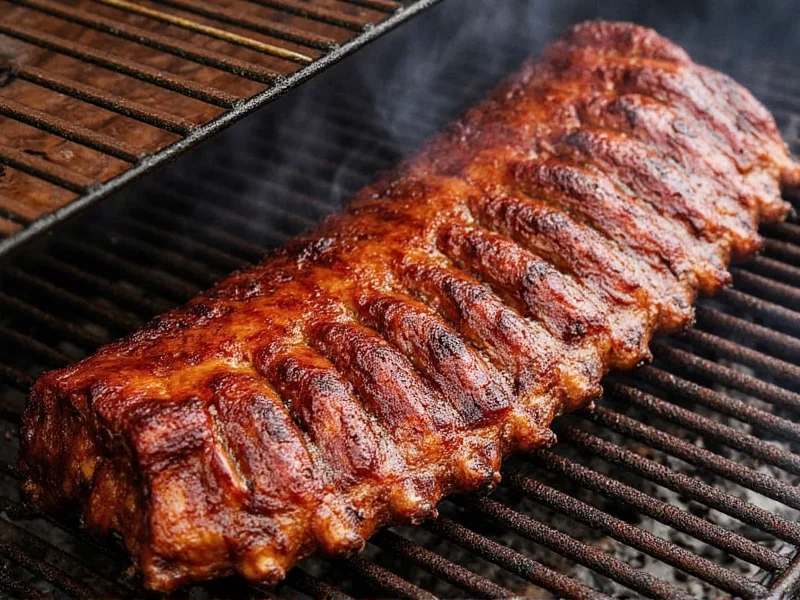Smoking ribs at the right temperature transforms tough connective tissue into succulent, fall-off-the-bone perfection. Many beginners make the critical mistake of setting their smoker too high, resulting in dry, tough ribs that never achieve that desirable texture. The 225-250°F sweet spot gives you complete control over the cooking process while developing complex smoke flavors.
Why Temperature Matters for Smoking Ribs
Ribs contain significant collagen and fat that require precise temperature management to break down properly. When you maintain a consistent 225-250°F:
- Collagen slowly converts to gelatin without evaporating moisture
- Fat renders gradually, basting the meat from within
- Smoke penetrates evenly without creating bitter compounds
- Meat fibers relax rather than seize up from high heat
Rib Types and Their Ideal Smoking Temperatures
While the 225-250°F range works for most ribs, slight adjustments optimize results for different cuts:
| Rib Type | Recommended Temp | Cooking Time | Internal Temp Target |
|---|---|---|---|
| Baby Back Ribs | 225-235°F | 4-5 hours | 190-203°F |
| St. Louis Spare Ribs | 235-245°F | 5-6 hours | 195-205°F |
| Beef Back Ribs | 240-250°F | 6-7 hours | 200-208°F |
| Country-Style Ribs | 230-240°F | 3-4 hours | 185-195°F |
Popular Rib Smoking Methods and Temperature Management
Professional pitmasters use specific techniques to maximize results within the ideal temperature range:
The 3-2-1 Method Temperature Guide
This popular technique requires precise temperature control throughout each phase:
- First 3 hours: Smoke uncovered at 225°F to develop bark and absorb smoke flavor
- Next 2 hours: Wrap in foil with liquid at 250°F to accelerate collagen breakdown
- Final 1 hour: Unwrap and return to 225°F to re-crisp the exterior
Maintaining Consistent Smoker Temperature
Fluctuations ruin rib texture. Follow these pro tips for temperature stability:
- Use a dual-probe thermometer to monitor both smoker air and meat temperature
- Position ribs away from direct heat sources in offset smokers
- Limit smoker openings to prevent temperature drops
- Adjust vents gradually—small changes create big temperature differences over time
- Account for weather conditions; cold winds require more frequent fuel adjustments
How to Know When Ribs Are Perfectly Cooked
Don't rely solely on time—use these visual and tactile indicators that your ribs reached ideal doneness at 225-250°F:
- Bend test: When lifted with tongs, ribs should bend freely and develop small cracks in the bark
- Meat shrinkage: Bones will protrude slightly as meat recedes (about 1/4 inch)
- Probe tenderness: A thermometer or skewer should slide into meat with little resistance
- Internal temperature: 190-205°F depending on rib type (see chart above)
Common Temperature Mistakes to Avoid
Even experienced smokers make these critical errors that affect rib quality:
- Starting too hot: Never begin smoking above 250°F—you'll seal in toughness before collagen breaks down
- Temperature swings: Fluctuations greater than 25°F cause uneven cooking and dry spots
- Ignoring ambient conditions: Wind and cold dramatically affect smoker temperature stability
- Over-relying on timers: Every rack of ribs cooks differently based on thickness and fat content
- Skipping the resting period: Always rest ribs for 15-20 minutes after smoking at 225-250°F to redistribute juices
Advanced Temperature Techniques for Competition-Style Ribs
For restaurant-quality results, consider these professional temperature strategies:
- Reverse sear finish: After smoking at 225°F, briefly increase to 350°F for 15 minutes to intensify bark
- Temperature ramping: Gradually increase from 225°F to 250°F during the final hours for faster rendering
- Cold smoke infusion: For extra smoke flavor without cooking, cold smoke at 80-100°F for 2 hours before standard smoking
FAQs About Smoking Ribs Temperature
Can I smoke ribs at 275 degrees Fahrenheit?
You can smoke ribs at 275°F, but this higher temperature requires careful monitoring. At 275°F, cooking time decreases to 3-4 hours, but you risk drying out the meat if not wrapped properly. Many pitmasters use 275°F for the final hour to speed up the process after initial smoking at 225°F, but starting at this temperature often produces less tender results than the traditional low-and-slow method.
What happens if my smoker temperature drops below 200 degrees?
If your smoker temperature drops below 200°F, the cooking process enters the food safety danger zone where bacteria can multiply rapidly. While brief dips won't necessarily ruin your ribs, prolonged periods below 200°F create food safety risks. If your temperature drops, gradually increase it back to 225°F rather than making drastic adjustments that could shock the meat. Always verify final internal temperature reaches at least 190°F to ensure safety and proper collagen breakdown.
Should I wrap ribs when smoking at 225 degrees?
Yes, wrapping ribs (the Texas crutch method) is highly recommended when smoking at 225°F, typically after 3 hours. Wrapping in foil or butcher paper with a liquid (apple juice, broth, or vinegar) creates a steam environment that accelerates collagen breakdown while preventing excessive moisture loss. This technique helps achieve that perfect fall-off-the-bone texture without drying out the meat during the extended cooking time required at 225°F.
How long does it take to smoke ribs at 250 degrees Fahrenheit?
At 250°F, baby back ribs typically take 4-5 hours, while St. Louis cut spare ribs require 5-6 hours. The exact time depends on rib thickness, meat marbling, and ambient conditions. Always use the bend test and internal temperature (190-205°F) rather than strict timing to determine doneness. Higher temperatures like 250°F produce slightly different texture than 225°F—often with more pronounced bark but potentially less smoke penetration.
What's the lowest safe temperature for smoking ribs?
The lowest safe temperature for smoking ribs is 225°F. Temperatures below 225°F keep meat in the food safety danger zone (40-140°F) for too long, increasing bacterial growth risk. While traditional barbecue sometimes uses temperatures as low as 200°F, this requires careful monitoring and shorter exposure to the danger zone. For home cooks, maintaining 225-250°F provides the safest and most reliable results for smoking ribs with proper texture development.











 浙公网安备
33010002000092号
浙公网安备
33010002000092号 浙B2-20120091-4
浙B2-20120091-4